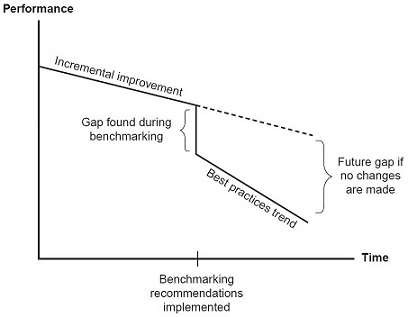
Unless your organization is the best in every aspect of your business, there are things to learn by comparing what you do, to how other organizations do it. The good news is that you don’t necessarily have to compare yourself to your competitors but to any organization who does something particularly well.
Overview: What is benchmarking?
While there is a common definition of benchmarking, there is no standard procedure for doing it. The following methodology was developed by Robert Camp who, in 1989, wrote one of the earliest books on benchmarking.
- Select subject – what aspect of your organization do you want to benchmark?
- Define the process – how are you going to do your benchmarking?
- Identify potential partners – who do you want to benchmark against?
- Identify data sources – where will you get the needed data?
- Collect data on both your organization as well as the one you are benchmarking against
- Determine the gap – where are the metric gaps between what you do and what the best in class does?
- Establish process differences – how do they do things versus how you do them
- Target future performance
- Communicate your findings to the rest of the organization
- Adjust goal – adjust any goals or targets to reflect desired changes
- Implement – execute the needed process changes
- Review and recalibrate – this is not a onetime activity
Benchmarking can help your organization identify areas, systems, products, or processes for improvement. These can be incremental, continuous improvements or breakthrough improvements. The graphic below shows the concept of incremental versus breakthrough improvements that can be achieved via benchmarking.

Incremental vs Breakthrough Improvement
An industry example of benchmarking
The VP of Finance was frustrated that month-end closing of the books was always late and took too long. He decided to benchmark their closing process against other companies noted for being the best in class for their financial processes. He chose companies who were not competitors in the hopes they would be more cooperative and open on how they do month-end closing.
After identifying three potential companies, he reached out to his counterparts and asked if they would agree to meet and discuss how they do their process. They all agreed, and meetings were held. After comparing the differences on how they did the process with how his company did it, the VP was able to identify major gaps.
The company’s Master Black Belt was engaged to help a Finance team do a process map of their current process and then recommend ways to improve it and significantly reduce the time for closing the books. The current time of 9 days was reduced to 3.
Frequently Asked Questions (FAQ) about benchmarking
What is the purpose of benchmarking?
Benchmarking is a strategy tool used to compare the performance of your organization’s business processes and products with the best performances of other companies inside and outside of your industry. This will allow you to identify best practices of the best in class to help you improve everything you do.
What are four types of benchmarking?
- Performance benchmarking involves gathering and comparing quantitative data on how other organizations are doing.
- Practice benchmarking involves gathering and comparing qualitative information about how people, processes, and technology issues are done by others.
- Internal benchmarking compares performance benchmarking and practice benchmarking from different units, product lines, departments, programs, geographies, etc., within your organization.
- External benchmarking compares your organization to others who may be doing a better job than you. These other organizations don’t need to be competitors.
What are some benchmarking best practices?
- Start early – If you want to be the best, it’s never too early to start benchmarking.
- Have a timeline – Benchmarking can demand a lot of time. Limit the scope of your benchmarking to a reasonable time period.
- Choose an appropriate peer group – The organizations you choose to benchmark against should be best in class for the element you wish to compare.
- Look outside your industry – Some of your best insights can come from organizations outside of your industry who are not competitors.
- Stick to meaningful metrics – Limit your benchmarking to a few factors that are standard so they can be easily compared.
- Focus on improving and closing the gaps.